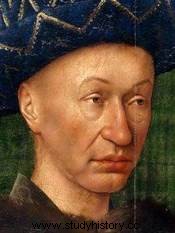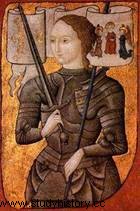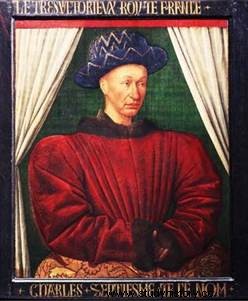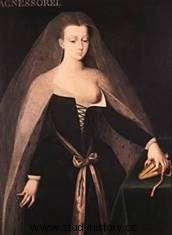 Charles VII (1403-1461), known as "the Victorious", was a king of France from the Valois dynasty. His reign, which lasted nearly forty years (1422-1461), is inseparable from the end of the Hundred Years War. It covers one of the most eventful periods in the history of France and can also be a time when one could believe in the disappearance of the Capetian dynasty. The epic of Joan of Arc will allow the "King of Bourges" to regain the throne and legitimacy, and to begin the reconquest of his kingdom from the English. Having become Charles VII the victorious, he will long remain in the shadow of the glory of the Maid of Orleans. This now rehabilitated little-known sovereign restored the authority of the monarchy in France, reforming and modernizing the finances and the army.
Charles VII (1403-1461), known as "the Victorious", was a king of France from the Valois dynasty. His reign, which lasted nearly forty years (1422-1461), is inseparable from the end of the Hundred Years War. It covers one of the most eventful periods in the history of France and can also be a time when one could believe in the disappearance of the Capetian dynasty. The epic of Joan of Arc will allow the "King of Bourges" to regain the throne and legitimacy, and to begin the reconquest of his kingdom from the English. Having become Charles VII the victorious, he will long remain in the shadow of the glory of the Maid of Orleans. This now rehabilitated little-known sovereign restored the authority of the monarchy in France, reforming and modernizing the finances and the army.
Charles VII, of the little "king of Bourges"...
Son of Charles VI the Fool and Isabella of Bavaria, Dauphin in 1417 after the suspicious deaths of his two older brothers, Charles seems quite puny to bear the enormous responsibility of raise the name and prestige of this ailing monarchy. Driven out of Paris during the struggle between Armagnacs and Burgundians, he took refuge in Bourges, where he held a small court with his last followers. At the same time, the King of England seized Normandy and Jean sans Peur, Duke of Burgundy, took over the government by joining forces with his mother, Isabeau of Bavaria, who declared Charles a "bastard".
John the Fearless tries to obtain the dolphin's alliance to hold him in his power. But their meeting, in Montereau, degenerates into an altercation. Jean sans Peur is killed. The revenge of the new Duke of Burgundy, Philippe le Bon, and Isabeau of Bavaria falls on Charles. He was deposed and disinherited in favor of the King of England, Henry V, by the Treaty of Troyes (1420), signed by Isabeau and Charles VI, already no longer in possession of his means. Henri V claims the crown of France while retaining France's institutions. Isabeau of Bavaria resists in vain. The premature death of Henry V on August 31, 1422 followed by that of Charles VI on October 21 did not change anything in the dual Lancastrian monarchy which was devolved to Henry VI, the Duke of Bedford ensuring the regency. But the Dauphin then claims to reign under the name of Charles VII. The war for the crown begins.
Yollande d'Aragon and the victory of La Brossinière
 A rather dull character, Charles is poorly surrounded and places too blind trust in unreliable advisers but who do not overshadow him, unlike the flamboyant lords of the time. The young Charles then found providential support in the person of Yolande d'Aragon, the wife of the Duke of Anjou, who happened to be his mother-in-law. It is through patient work that Yolande forges agreements and reconciliations, in order to present a united front to the invader.
A rather dull character, Charles is poorly surrounded and places too blind trust in unreliable advisers but who do not overshadow him, unlike the flamboyant lords of the time. The young Charles then found providential support in the person of Yolande d'Aragon, the wife of the Duke of Anjou, who happened to be his mother-in-law. It is through patient work that Yolande forges agreements and reconciliations, in order to present a united front to the invader.
In 1423, the Battle of La Brossinière was the first significant victory for the French armies. After the raid undertaken by the Duke of Suffolk Lord William Pôle, throughout Maine and Anjou, Queen Yolande of Aragon convinces several supporters of her son-in-law the King of France to intervene militarily to avenge the damage suffered. Ambroise de Loré, as well as the Comte d'Aumale and de Mortair Jean VIII d'Harcourt, in particular, gather their troops and prepare an ambush on the way back traveled by the English.
After a quick skirmish between the scouts, the French knights charge in battle order and force the English to dismount. Despite strong resistance, the English troops were decimated and few soldiers escaped French reprisals. This victory of the king's supporters is the starting point for a gradual reconquest of the land of France.
Joan of Arc and Charles the Victorious
Militarily, the situation remains precarious despite the success achieved at La Brossinière. The English won several victories near Crevant (1423) and Verneuil (1424). And above all they come to lay siege to Orléans. If the city yields, the English will be able to reach the south of the Loire and reach Charles in his last refuge. It was then that a young Lorraine shepherdess from Domrémy intervened providentially... Charles only regained his legitimacy after his recognition by Joan of Arc who delivered Orléans (1429) and had him crowned in Reims on July 17, 1429. With Jeanne, he undertook the reconquest of the kingdom partly occupied by the English and their Burgundian allies. The reconquest of part of the regions north of the Loire is successful, but Joan of Arc is burned in Rouen (May 30, 1431). Charles VII hardly exposes himself to save her. We speak of "cowardly abandonment".
 In order to detach the Burgundians from the King of England, Charles VII grants important concessions to the Duke of Burgundy, Philip III the Good, at the Treaty of Arras (1435). The Anglo-Burgundian alliance is broken. Reconquered Paris, the king made a triumphal entry there in 1437 but hardly stayed there, preferring his castles of Berry and Touraine. Normandy and then Guyenne (1450-1453) were reoccupied thanks to remarkable warriors.
In order to detach the Burgundians from the King of England, Charles VII grants important concessions to the Duke of Burgundy, Philip III the Good, at the Treaty of Arras (1435). The Anglo-Burgundian alliance is broken. Reconquered Paris, the king made a triumphal entry there in 1437 but hardly stayed there, preferring his castles of Berry and Touraine. Normandy and then Guyenne (1450-1453) were reoccupied thanks to remarkable warriors.
Rouen rises and opens its doors to Charles VII, who makes a triumphal entry alongside Jacques Coeur (1449). The English retaliated by sending an army, which landed in Cherbourg and headed for Caen, but was defeated by the French near Formigny (1450). In Guyenne, it was the victory at the Battle of Castillon (1453) that kept the English away. Soon, these only keep Calais in France. With the Hundred Years War over (although no treaty was concluded), Charles VII devoted himself to reorganizing his kingdom.
Charles VII's reforms
He fights against the Flayers, who infest the country, by maintaining permanent troops responsible for restoring security, he convenes the Estates General in Orleans. Some lords, dissatisfied with the progress of royal authority and encouraged by the Dauphin Louis (future King Louis XI), rose up. Charles triumphed over these revolts, named "Pragueries" in reference to the troubles in Bohemia. He created (1445-1448) a standing army, with a cavalry of ordinance companies, recruited from the nobility, and an infantry of franc archers composed of commoners exempt from the size (hence their name).
The currency is stabilized, regular taxes raised make it unnecessary to convene the Estates General and France is experiencing a commercial revival thanks to Jacques Cœur, grand treasurer of the king. The latter signed the great ordinance of Saumur in the autumn of 1443, while various measures were taken to revive trade in a country living in slow motion, privileges were granted to the great fairs of Lyon and Champagne, silk weaving looms were created. Signaling himself once again by his ingratitude, Charles VII sacrifices Jacques Coeur to the jealousy of the courtiers (1453) and the great treasurer will end his days ruined and banished.
Charles also regulated the affairs of the Church during a national council held in Bourges in 1438. A "pragmatic sanction" gave the French churches a certain freedom and reduced the tributes levied by the pope on ecclesiastical benefices under the title of annals, reserves, expectations.
He orders that the various customs of the land be written down. This wording announces the unity of the laws. He created two new parliaments:Toulouse (1447) and Grenoble (1453). The end of his reign was marked by a commercial revival and the strengthening of royal authority. In the end, only one danger remains:the power of the Duchy of Burgundy.
A favorite and a rebellious son
 An innovation destined for long posterity, the reign of Charles VII saw the public appearance of a royal favourite, under the pleasant features of Agnès Sorel. Around 1443, she became the king's mistress perhaps following the maneuvers of Pierre de Brézé, whose ascendancy then extended over royal policy. The king showered her with presents, making her chatelaine of Loches, lady of Beauté-sur-Marne (hence her nickname “Lady of Beauty”), and countess of Penthièvre. He legitimizes the three daughters she bears him in the early years of their affair.
An innovation destined for long posterity, the reign of Charles VII saw the public appearance of a royal favourite, under the pleasant features of Agnès Sorel. Around 1443, she became the king's mistress perhaps following the maneuvers of Pierre de Brézé, whose ascendancy then extended over royal policy. The king showered her with presents, making her chatelaine of Loches, lady of Beauté-sur-Marne (hence her nickname “Lady of Beauty”), and countess of Penthièvre. He legitimizes the three daughters she bears him in the early years of their affair.
Her presence at court overshadows that of the queen, Marie d'Anjou, as she likes to bare her shoulders and sport extravagant outfits and hairstyles. She gets her supplies from the businessman Jacques Coeur with whom she probably has an affair. Agnès Sorel exerted a real (although exaggerated) influence on the royal government, often linked to that of the Brézé.
King Charles VII married Marie d'Anjou. He was even brought up at the court of Anjou, which explains the influence of Yolande d'Aragon, Marie's mother, on him. The royal couple have twelve children, five of whom survive. Among them, the Dauphin Louis and future Louis XI. At odds with his father, he tainted the life of the Court with his plots, to the point that the king exiled him in 1447. He would never see his son again until his death in Mehun-sur-Yèvre on July 22. 1461.
Bibliography
- Charles VII:a life, a policy, by Philippe Contamine. Perrin, April 2017.
- Charles VII:The Victorious, by Georges Bordonove. Pygmalion, 2006.
- Charles VII and his mystery, by Philippe Erlanger. Gallimard, 1982.
